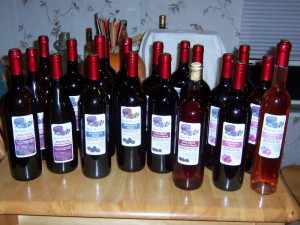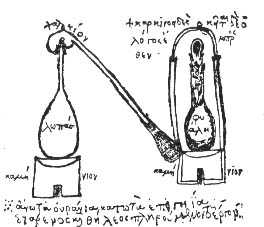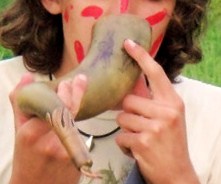 What’s so special about mead? This question has been on my mind a lot recently. It’s a valid question. I’ve been head-over-heels in love with mead for a while now, and such devotion tends to create blind spots in one’s understanding. I find it useful to periodically identify and examine some of these blind spots.
What’s so special about mead? This question has been on my mind a lot recently. It’s a valid question. I’ve been head-over-heels in love with mead for a while now, and such devotion tends to create blind spots in one’s understanding. I find it useful to periodically identify and examine some of these blind spots.
There are many things about mead that differentiate it from any other drink — alcoholic or not — that I’ve experienced. This article will talk about some of these differences.
Mead Is a Natural Beverage
First off, unlike any other sort of alcoholic drink, mead is a natural beverage, meaning it can happen without human intervention in nature. If rainwater fills an abandoned beehive and the mixture is charged with wild yeast in the air, fermentation will occur producing ethanol (the edible form of alcohol) and mead will be the result. This is not true for beer, which requires mashing, malting, and sparging grains (usually barley) to extract their sugars for fermentation, or for spirits, which require a complex distillation process that we’ve only been doing for a few hundred years. Wine is a bit closer to being a natural beverage, but the grapes must be crushed and liquefied somehow for fermentation to happen.
Furthermore, as far back as we can see into history, we find mead in all parts of the planet. Mead is perhaps most associated with northern European cultures, but it is also part of culture in Africa, the Americas, Asia, and among the aboriginal Australians.
Inspiration and Poetry
Mead is old enough to be encoded in the mythologies of most of the cultures it exists within. For instance, in Norse mythology, it is called the “mead of inspiration” and is renowned for its ability to loosen the poet’s tongue, resulting in the ability of the poet to see connections that would otherwise remain hidden. Absent are the archetypes of ethanol consumption prevalent in our culture: the frat party where pledges take turns vomiting in the bushes, the exuberant but not-so-coherent heckler at a sporting event, or the wino slumped against a loading dock, swilling his addiction from inside a brown paper bag, his life destroyed.
Mead is alcohol. You can get drunk from it, and it is most definitely intoxicating when consumed in quantity. But the effects of mead seem different to me, both in my personal experience and in my observations of people indulging in it. We all know the stereotype associated with ethanol consumption in our culture: someone drinks too much. their speech is slurred, and some of their most intense personality traits are further intensified. Some may become violent.
Yet mead somehow seems to raise the vibration of the gathering, lifting the spirits of those sharing it. Ancient texts refer to mead as “bringing wisdom” or allowing people to begin to “thrive,” bringing inspiration and facility with poetry (see, for instance, The Poetic Edda from Norse culture).
I was speaking with Eli Cayer from Urban Farm Fermentory about this phenomenon last week on our way to the MeadFest 2011. He told me a story of his first experience with mead, where it raised the vibration of the party, everyone had a good time, and there was no trouble. This theme is all-too-familiar with mead gatherings I have attended.
What is it about mead that is related to the energy of the people drinking it? I think there are several reasons for this profound relationship between mead and consciousness. The most obvious is honey. Honey is a profound food, probably the most magical naturally-occurring sweetener on Earth. At the risk of quasi-new-age mumbo jumbo, honey seems to be at a higher vibration than other available sugars. I notice a huge difference between mead and beers, for instance; much of this difference I attribute to the superiority of honey over extracting sugars from grains, a practice that is rooted in monocrop agriculture and therefore a relatively recent (and problematic) addition to the human experience.
Mead is a very wide spectrum of different drinks
Compared to (for instance) beer, mead has an extremely wide range of types and flavors. While beers such as a light wheat ale or a deep brown stout will not taste the same, they are at least in the same ballpark, they are both beer, with the malty flavor of barley and the bitterness of hops to some degree. Yet, even a plain, traditional mead made from only honey, water, and yeast can vary considerably in alcohol content (0-20% or so) and on the sweet/dry spectrum. But mead really starts to get interesting when one considers the huge spectrum of additives that can be used to flavor the mead. Adding favorite fruits or berries produces a melomel (fruit mead); adding spices produces a metheglin (spiced mead); mead made with apple cider rather than water is called cyser; mead made with grape juice is called pyment; then there are the nontraditional meads and herbalism, both of which can produce a unique beverage. All of these means will be profoundly influenced by the qualities of the ingredients used.
For instance, honey is the lifeblood of an ecosystem. Its characteristics will reflect the flowers and plants whose nectar is collected by the bees that made the honey. My favorite honey produced by my local apiary is raspberry honey, where the bees take nectar from raspberry plants within range of the hives. This honey is delicious, with the unmistakable tang of raspberries tucked inside the sweetness of the honey.
Even the qualities of the water used in the honey will affect the final product. For me, my brews always begin with some of the best water available on Earth — spring water that I harvest myself from a mountaintop spring in glass containers. Even if you don’t go to such extremes, using the best water available will contribute to the mead being the best it can be.
If mead is so special, why did it fall out of favor 500 years ago?
This is a very interesting question, I found out. It’s hard to give a simple answer. In the thinking and researching I’ve done, I’ve discovered it’s important to take that period of history into context. This was a time of tremendous change in Europe. Every aspect of culture was in transition:
- This was the time of the Renaissance, the Enlightenment, and the Scientific Revolution;
- The New World was under frantic colonialism and exploration;
- Capitalism was taking root economically, transitioning away from feudalism;
- Smoke from the witch hunts was ubiquitous (which are one of the first globalized examples of mass genocide: most of Europe was at war with one another, but virtually all these countries were in agreement that burning witches was an appropriate strategy). This practice severely reduced the number of wise-women healers and shamans, who traditionally were responsible for the health of the tribe;
- Land enclosure and large-scale monocrop agriculture were widely practiced for the first time.
A good example of how these shifts manifested in Europe the is the Reinheitsgebot (or Purity Act), passed in 1516 in Germany:
in all cities, markets and in the country, the only ingredients used for the brewing of beer must be Barley, Hops and Water. Whosoever knowingly disregards or transgresses upon this ordinance, shall be punished by the Court authorities’ confiscating such barrels of beer, without fail.
 This law had profound effects on humanity’s relationship with ethanol. Prior to this law, throughout Europe there were Gruit Guilds, that is, herbal supply guilds, whose recipes and herbal mixtures had been perfected over centuries and handed down countless generations. It used to be, one went to the “pub” to get an ale for what ails you; there would be a variety of brews available, depending on the herbal effects desired.
This law had profound effects on humanity’s relationship with ethanol. Prior to this law, throughout Europe there were Gruit Guilds, that is, herbal supply guilds, whose recipes and herbal mixtures had been perfected over centuries and handed down countless generations. It used to be, one went to the “pub” to get an ale for what ails you; there would be a variety of brews available, depending on the herbal effects desired.
The Purity Act wiped these guilds out, by specifying that the only acceptable herb to brew with was hops. What do we know about hops? As an herb it is highly estrogenic, which contributes to the stereotype of men who consume too much beer, with their increasingly goddess-shaped figures. Hops are a sedative, and they reduce the sex drive. By mandating that all legal brews must contain hops, the Ingolstadt magistrates ensured a more docile (and less healthy) populace, and by mandating confiscation of traditional herbal brews, they ensured that the healthiest drinks would be available (legally) only to them.
Another reason contributing to mead’s fall-from-grace is the relative scarcity of honey, especially compared to the unprecedented yield of monocropped grains taking root in the economic culture at the birth of capitalism, along with the fundamental feature of capitalism called “enclosure.” Land Enclosure allowed parcels of land to be enclosed from the common, razed to the soil, and only one plant allowed to grow. The patchwork quilt-like appearance of the English countryside, for instance, is a visual testament to centuries of land enclosure.
 Finally, this period saw mass distillation of alcohol available to people for the first time in history. There is a “ceiling” to the amount of alcohol that fermentation alone can produce — when the alcohol content of a fermenting beverage reaches 15 or 20%, it creates a toxic environment in which the alcohol-producing yeast can no longer survive. Apart from being a fascinating metaphor (can you think of another organism that gradually toxifies its ecosystem until it can no longer sustain life?), it meant that the strongest alcoholic drinks were no more than about 20% alcohol at the most.
Finally, this period saw mass distillation of alcohol available to people for the first time in history. There is a “ceiling” to the amount of alcohol that fermentation alone can produce — when the alcohol content of a fermenting beverage reaches 15 or 20%, it creates a toxic environment in which the alcohol-producing yeast can no longer survive. Apart from being a fascinating metaphor (can you think of another organism that gradually toxifies its ecosystem until it can no longer sustain life?), it meant that the strongest alcoholic drinks were no more than about 20% alcohol at the most.
By the 1500s and 1600s, the alchemists’ secret of distillation was commodified and unleashed onto the public. By evaporating and then re-condensing the alcohol, spirits were created which could be up to about 95% alcohol — common spirits we know today such as whiskey, rum, vodka, tequila, and all the others. It is also interesting to note that the phenomenon of widespread alcoholism was relatively unknown until this period in history.
All of these factors contributed to mead losing popularity, remaining a rustic novelty drink with a few diehard enthusiasts keeping the tradition alive in a culture besotted with beers, wines, and spirits. Here were are now in the 21st century, with corporate-produced beers dominating the ethanol consumption across the globe.
Mead is making a comeback
As I write this in 2011, mead is making a comeback and is increasing dramatically in popularity. Micromeaderies are opening in every town, mirroring the Microbrew phenomenon of 20 years ago, when brewpubs seemed to pop up on every corner of the urban landscape.
But the real story is with homebrewers. More and more people are making mead, experimenting and discovering an entirely new way to be in relationship with one’s ecosystem. The qualities of ingredients and techniques used are both phenomena of place. Each bottle of mead will have its story, of how it came into being in that place.
Every bottle has its story
I love all of my brews, but the ones whose ingredients I wild-harvest myself often have the most meaning to me. Sometimes, I will do a spring run, a honey run, and forage on the same trip, harvesting my ingredients at the same time, with intent.
For instance, I can point to the spruce trees from which I took the leaves in my Spruce Tip Mead. Medicinally, I have been bonding with the Elecampane Mead for a while, getting to know this plant and feeling its effects on my body. The run of berry meads I did last summer were a testament to the ripening season, as each berry was done when it was ripe.
When you make — and consume — your own mead, with intent and a certain amount of reverence, you can resonate with its story. And if you age a few of the bottles, you’ll be able to share these stories far into the future.





